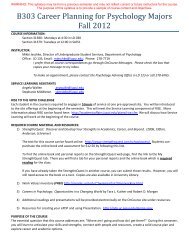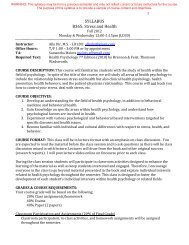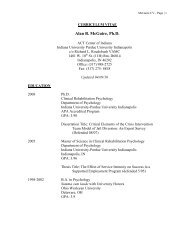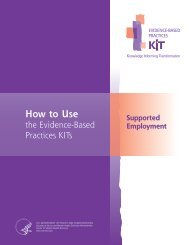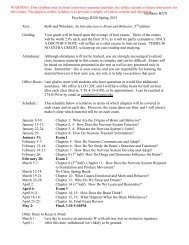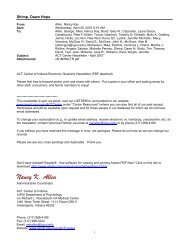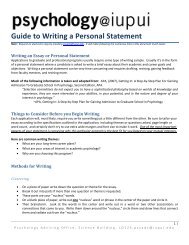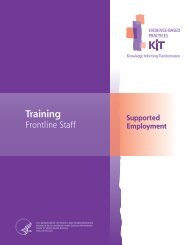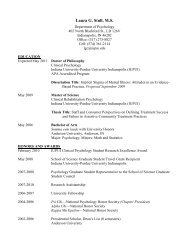Supported Employment: Building Your Program - SAMHSA Store ...
Supported Employment: Building Your Program - SAMHSA Store ...
Supported Employment: Building Your Program - SAMHSA Store ...
- No tags were found...
You also want an ePaper? Increase the reach of your titles
YUMPU automatically turns print PDFs into web optimized ePapers that Google loves.
Develop a training planDeveloping an SE team is a complex undertaking.Recruiting and retaining employment specialistswho know the SE model or who know how to treatconsumers can be difficult. Agencies that havesuccessfully implemented an SE program indicatethat offering one-time training for employmentspecialists is not enough. Instead, you shouldassess the knowledge level of key stakeholders(See Evaluating <strong>Your</strong> <strong>Program</strong>) and developa training plan.What should your trainingplan include?• Basic training for key stakeholders, includingconsumers, families, mental health authorities,and members of key community organizations• Basic training for staff at all levels acrossthe agency• Intensive training for employment specialists• Basic training on benefits and work incentivesPractitioners who implement evidence-basedpractices (EBPs) are often stymied in their effortsbecause people misunderstand the model or lackinformation. It is important that key stakeholders(consumers, families, and other essentialcommunity members) and agency-wide staffdevelop a basic understanding of SE.This training will build support for your SEprogram. <strong>Your</strong> SE staff will find that they are betterable to generate referrals for their SE program,develop job leads, and provide job supports. Sinceeffective SE services depend on integrating SE andclinical services, it is important for all members ofthe treatment team to have a basic understandingof the SE model.Additionally, consumers, families, and other keystakeholders may hold misconceptions aboutconsumers’ ability and desire to work or how workmay affect their benefits. It is important to correctfalse beliefs before they impede implementing yourSE program. Consider organizing routineeducational meetings for consumers, families, orother key stakeholders in which consumers whohave received SE services or employers who havehired consumers through an SE program sharetheir experiences. For materials to support thisbasic training, see Using Multimedia to Introduce<strong>Your</strong> EBP. You will find these resources: An introductory PowerPoint presentation; A sample brochure in both English and Spanish;and The introductory video.Once trained, SE leaders and employmentspecialists will be able to use these materials toconduct routine community workshops and inserviceseminars. Furthermore, the SE KITincludes Training Frontline Staff, which givesemployment specialists in-depth information aboutthe SE model and skills for providing SE services.SE leaders may facilitate a structured grouptraining using these materials.Once employment specialists have a basicunderstanding of the model, we recommend thatthey visit an existing, well-functioning, high-fidelitySE team to observe how employment specialistswork with consumers and how they interact withone another.In addition to in-depth training on the SE model, wealso suggest that you offer basic training on benefitsand work incentives to employment specialists andother practitioners. <strong>Employment</strong> specialists shouldbe able to define the following terms: Medicaid and 1619B Medicaid; Medicaid for the Working Disabled; Medicare;<strong>Building</strong> <strong>Your</strong> <strong>Program</strong> 37 Tips for Agency Administrators and SE Leaders



